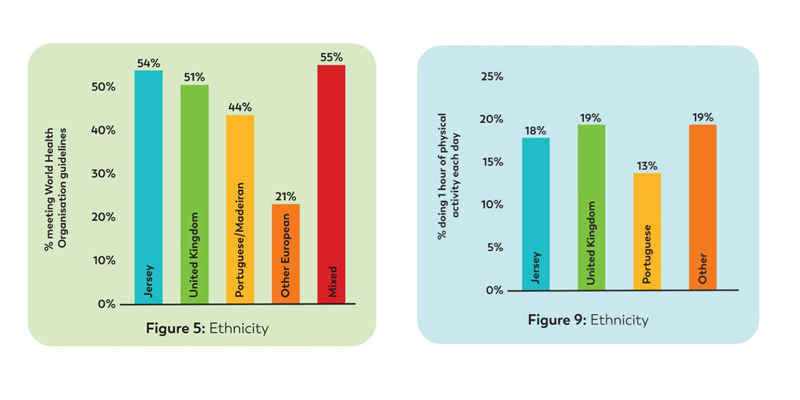INCLUSION IN SPORT
NATIONALITY AND ETHNICITY

Data shows physical activity levels differ hugely between ethnic backgrounds in Jersey. In Figure 5 below, you can see that an adult who has a ‘Jersey’, ‘United Kingdom’ and ‘Mixed’ ethnic background are more physically active compared to those who have European ethnic background. This is the same for young people in Figure 9. The types of sport and physical activity also differ between ethnic groups and for some there is a larger difference between men and women who are physically active. These trends are very similar to data from religion and faith groups.

This pattern is very similar in England, where people who have a ‘Mixed’ or ‘White Other’ ethnic background have higher physical activity levels compared to ‘South Asian’, ‘Black’ and those with other ethnic origins. More information about Sport England’s Active Lives Adult Survey from 2021-22 can be found online: (Active Lives Adult Survey November 2021-22 Report (sportengland-production-files.s3.eu-west-2.amazonaws.com)
Sport England have also highlighted how individuals from ‘Black’, ‘Asian’ and ethnically diverse communities in England are more likely to experience disadvantages due to low socio-economic factors when it comes to participating in sport and physical activity. The differences in activity levels between adults from different ethnic backgrounds have been a persistent feature of data for several years, as have the inequalities in the physical activity levels of different ethnic backgrounds in children and young people. The full 2020 report which looks at why ethnicity and culture matter in sport and physical activity can be viewed online: (PowerPoint Presentation (sportengland-production-files.s3.eu-west-2.amazonaws.com)
BARRIERS TO PARTICIPATION
- Fear of experiencing racism
- A lack of understanding, education or dismissal of cultural traditions by volunteers/coaches/instructors
- Associated costs to exercising, such as membership fees, equipment and travel
- Lack of understanding and knowledge around physical activity and its importance
- Training or playing days/times conflicting with cultural traditions
- A lack of translated communications and promotions to fully understand the language and meaning
- A lack of representation and people who ‘look like me’ within sport offers
STRATEGIES TO ENCOURAGE PARTICIPATION
- Ask your participants how you can make your sport setting a safe, welcoming and inclusive environment for them to be and stay involved
- Seek further understanding and ask ethnically diverse communities what would help them by holding focus groups or collaborating with charities who work with ethnically diverse communities
- Encourage ethnically diverse representation at all levels of your sport organisation, from coaches, to volunteers, to executive committee members
- Utilise community-based programmes and initiatives that can help remove the financial and logistical barriers that prevent many individuals from participating
- Address and actively call out unconscious bias and discriminative behaviour by having open and honest conversations about the impact of prejudice and holding people accountable for any discriminatory behaviour
- Provide support and resources to those who have experienced discrimination, for example creating a safe space for individuals to share their experiences to educate others
- Work in partnership with other local sports organisations, charities and authorities to address discrimination and share good practice about creating inclusive spaces
- Celebrate equality and diversity within your sport setting by highlighting the stories and experiences of ethnically diverse communities and promoting the representation of these participants across your social media channels and within your facility
LANGUAGE AND TERMINOLOGY
The way we talk to, about and how we address ethnically diverse communities is essential in creating an inclusive and safe sport environment and ensuring lifelong engagement with physical activity. Sadly, for many individuals, their experience of racial discrimination has caused impact not only on their participation in sport, but their wider lifestyle and day-to-day living. Understanding what is and what is not appropriate terminology and language will help us as a local community have respectful discussions around racial discrimination and inequality. In the first instance, always ask the individual or group what language or terms they would like you to use and ensure that you seek guidance on pronunciation where appropriate. Some helpful starter tips can be found in the table below:
| Avoid | Use |
| Black Asian and Minority Ethnic (BAME) or Black and Minority Ethnic (BME) | Be specific about who you are describing, e.g. British Black African heritage, British Pakistani heritage |
| Minority Ethnic or Ethnic Minority | If a generic term is needed, then use ‘ethnically diverse communities’ or ‘historically underrepresented ethnic communities’ and ‘culturally diverse communities.’ Explain any generic terms with more specific descriptions of who you are looking to engage. |
| Coloured | Be more specific (see above). If you are defining groups who have experienced racism, then use ‘people who experience racism’ or ‘communities who have been impacted by racism.’ Follow up with more detail on who you are describing. |
| Blacks | Be specific about who you are describing, e.g. Ghanaian Heritage, British Jamaican Heritage, Senegalese, Ethiopian, African Caribbean, people of African or Caribbean heritage |
| Hard to reach | ‘People or communities who face barriers to participation or engagement with sport and physical activity’, ‘Underrepresented communities’ or ‘Disengaged communities’ |
| People of Colour | Be more specific on who you are describing, e.g. African communities, Caribbean, Somali, Nigerian Heritage, Grenadian, Indian, Vietnamese |
Sometimes for administrative purposes like websites, presentations or policy use, collective terminology is needed or most appropriate. In these cases, use terms such as ‘ethnically diverse communities’, ‘historically underrepresented communities’, or ‘culturally diverse communities’ to refer to those communities that face racism and/or inequality due to not being described as ‘White’, and diverse ethnic communities when attempting to create more diversity amongst all ethnic groups, including ‘White’ communities.
For further information on the above please follow: Terminology_Resource.pdf (sportingequals.org.uk)
